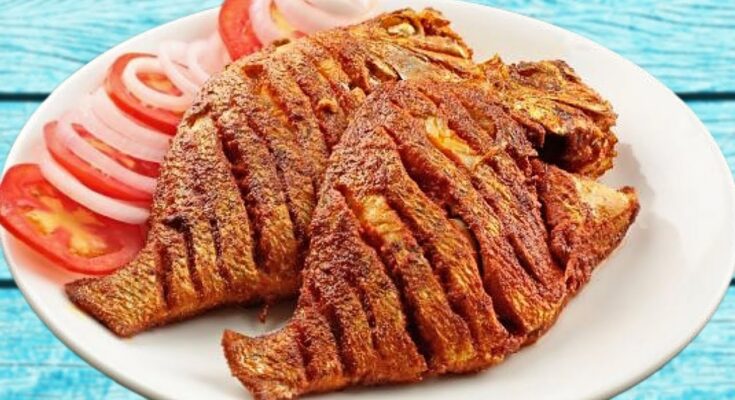Fish Fry Recipe: There’s something undeniably satisfying about the crispy crunch of a perfectly fried fish. Whether you’re indulging in a coastal seafood platter or whipping up a quick dinner at home, a good fish fry recipe is a must-have in any kitchen. It’s a dish that transcends cultures—loved from the American South to Indian coastal towns and Caribbean islands. But what makes a fish fry unforgettable? It’s not just about dunking fish in hot oil; it’s a process, a balance of flavors, textures, and techniques.
In this guide, we’ll break down everything you need to master the art of a crispy, golden fish fry at home. Whether you’re a beginner or a seasoned cook looking for a refresh, we’ve got you covered.
Ingredients You’ll Need
Before you begin, gather all your essentials. Here’s a simple yet flavorful list of ingredients to make your fish fry pop with taste:
Basic Ingredients:
- 500g fresh fish fillets (tilapia, catfish, cod, or your favorite)
- 1 tablespoon lemon juice
- 1 teaspoon salt
- 1 teaspoon turmeric
- 1 tablespoon chili powder or paprika (depending on your spice tolerance)
- 1 tablespoon ginger-garlic paste
- 1 teaspoon black pepper
For the Coating:
- 1/2 cup rice flour or cornmeal (for extra crunch)
- 1/2 cup all-purpose flour
- 1 egg (optional for binding)
- Water or buttermilk (to make a smooth batter if wet coating is used)
Optional Additions:
- Chopped coriander leaves or parsley
- Crushed fennel or cumin seeds
- A pinch of garam masala or Cajun seasoning for regional twist
All these ingredients come together to create layers of flavor that coat the fish and enhance every bite.
Choosing the Right Fish
The key to a stellar fish fry lies in choosing the right fish. You want something firm, flavorful, and easy to cook without falling apart. Here are a few top picks:
Best Fish for Frying:
- Tilapia – Mild and firm, perfect for beginners.
- Catfish – A Southern favorite, meaty and hearty.
- Cod – Flaky with a neutral taste that absorbs spices well.
- Snapper – Popular in Caribbean recipes.
- Salmon – For a richer taste, though it needs careful seasoning.
Freshness Tips:
- Always choose fish with a fresh sea smell—not fishy or sour.
- The flesh should be firm and bouncy.
- If using frozen fillets, thaw them completely and pat dry before marinating.
Fresh fish not only tastes better but also fries more evenly, giving you that coveted crispy edge with a juicy center.
Marination Magic
Think of marination as the soul of your fish fry. This step infuses the fish with flavor, tenderizes it, and sets the tone for how it will taste after frying.
Why Marinate?
- Enhances flavor through the meat
- Adds moisture and prevents drying
- Helps the coating stick better
How to Marinate:
- In a bowl, mix lemon juice, salt, turmeric, chili powder, pepper, and ginger-garlic paste.
- Rub this mixture thoroughly over the fish fillets, ensuring every inch is coated.
- Let it sit for at least 30 minutes. For deeper flavor, refrigerate for 1-2 hours.
Want to spice things up? Add a dash of hot sauce or mustard to the marinade. Some even swear by soaking the fish in buttermilk first to tenderize and reduce any strong smell.
Preparing the Batter or Coating
This is where your fish goes from tasty to tempting. There are two primary routes: a dry spice rub or a wet batter. Both have their own charm.
Dry Rub Coating:
- Mix rice flour, cornmeal, and a bit of your favorite spice mix.
- Dredge the marinated fish until fully coated.
- Ideal for shallow frying.
Wet Batter Coating:
- Whisk flour with a little water or buttermilk to make a smooth batter.
- Add an egg for extra crispiness.
- Dip the fish fillets and let the excess drip before frying.
You can also experiment here—add finely chopped herbs to the batter, or use crushed cornflakes for an added crunch. Don’t be afraid to mix and match.
Step-by-Step Fish Fry Process
Now that you’ve got your fish marinated and your coating ready, it’s time for the fun part—frying! This step brings everything together into that irresistible, golden-brown masterpiece.
Step-by-Step Instructions:
Heat the Oil
- Pour oil into a heavy-bottomed skillet or deep fryer.
- Heat on medium flame until it reaches about 350°F (175°C). If you don’t have a thermometer, drop a small piece of coating into the oil—if it sizzles and rises quickly, it’s ready.
Coat the Fish
- Take the marinated fish and either dredge it in the dry mix or dip it into your batter.
- Let the excess coating or batter drip off to prevent sogginess.
Start Frying
- Carefully place each piece into the hot oil.
- Do not overcrowd the pan—this drops the oil temperature and makes the fish greasy.
- Fry for 3-4 minutes per side (depending on thickness) until golden and crisp.
Drain and Rest
- Remove the fish and place it on a wire rack or paper towel to drain.
- Let it rest for 2 minutes before serving so the coating sets.
Whether you’re shallow frying or deep frying, keeping an eye on the heat and not flipping too often will give you perfect results.
Tips for Perfect Frying
Frying fish is both an art and a science. To nail that perfect golden crust without drying out the inside, follow these expert tips:
1. Temperature Control Is Key
- Too hot, and your fish will burn before it cooks inside.
- Too cold, and it will absorb oil and become greasy.
- Ideal range: 350°F to 375°F (175°C to 190°C).
2. Use the Right Oil
- High smoke point oils like canola, peanut, or sunflower are best.
- Avoid butter or olive oil for frying—they burn too quickly.
3. Don’t Flip Too Much
- One flip is usually enough. Let each side cook undisturbed to form that perfect crust.
4. Drain the Right Way
- Skip the plate with paper towels if possible—use a wire rack to keep the coating crisp.
- If you must use towels, pat lightly but don’t cover the fish completely.
These simple tricks go a long way in ensuring that each bite is crispy on the outside and tender on the inside—just the way a great fish fry should be.
Serving Suggestions
Now that you’ve got a plate full of crispy fried fish, what do you serve with it? The right sides can elevate your fish fry from good to unforgettable.
Classic Sidekicks:
- French Fries or Potato Wedges – A no-brainer pairing.
- Coleslaw – Adds a creamy, tangy crunch to balance the richness.
- Steamed Rice or Fried Rice – Ideal for an Indian or Asian twist.
Fresh Accompaniments:
- Lemon Wedges – Squeeze just before eating for that extra zing.
- Fresh Salad or Slaw – Cucumber, onion, and tomato salad with a dash of vinegar works wonders.
- Chutneys and Dips – Mint chutney, tartar sauce, or even a spicy aioli.
Garnish and Presentation:
- Sprinkle some freshly chopped coriander or parsley on top.
- Serve on a banana leaf for a tropical vibe or on a wooden platter for rustic charm.
Remember, presentation is half the flavor. Even a simple fish fry can feel like a restaurant meal with the right sides and serving style.
Storage and Reheating Tips
Cooked too much? No worries. You can store and reheat fried fish while keeping its crunch—if done correctly.
How to Store:
- Let the fried fish cool completely before storing.
- Place in an airtight container lined with paper towel.
- Store in the refrigerator for up to 3 days.
How to Reheat Without Losing Crispiness:
- Oven Method (Best):
- Preheat oven to 375°F (190°C).
- Place fish on a wire rack over a baking tray.
- Heat for 10–12 minutes until the outside is crispy again.
- Air Fryer:
- Quick and efficient—3-5 minutes at 375°F (190°C).
- Avoid Microwave:
- It turns the coating soggy and ruins the texture.
Proper storage and reheating not only prevent waste but also let you enjoy that fish fry flavor all over again—without compromise.
Common Mistakes to Avoid
Even seasoned cooks can mess up a fish fry. Here are the most common blunders and how to avoid them:
1. Using Wet Fish
- Always pat fish dry before marinating or coating.
- Moisture causes splattering and prevents the coating from sticking.
2. Overcrowding the Pan
- This lowers the oil temperature, resulting in soggy, uneven frying.
- Fry in small batches for best results.
3. Inconsistent Coating
- Make sure the fish is evenly coated.
- If using a batter, don’t let it get too thick or too runny.
4. Not Preheating the Oil
- Cold oil = greasy fish.
- Always heat the oil to the correct temperature before frying.
5. Flipping Too Much
- Handle your fish gently and flip just once.
- Let it rest after frying to lock in the flavors and crunch.
Avoiding these pitfalls can make all the difference between a soggy mess and a perfectly crispy, delicious fried fish.
Healthier Alternatives
Love fish fry but worried about the calories and oil? No worries! You can enjoy the same deliciousness with some healthier cooking techniques that don’t sacrifice flavor.
1. Air Fryer Fish Fry
- Coat your marinated fish lightly in breadcrumbs or cornmeal.
- Spray with a bit of oil.
- Air fry at 375°F (190°C) for 12–15 minutes, flipping halfway through.
- Result: crispy outside, juicy inside, and 70% less fat.
2. Oven-Baked Fish
- Preheat your oven to 400°F (200°C).
- Place coated fish on a baking sheet lined with parchment or foil.
- Drizzle or spray with oil.
- Bake for 20 minutes, turning once.
- For extra crispiness, broil for the last 2–3 minutes.
3. Pan-Frying with Minimal Oil
- Use a non-stick pan and just 1–2 tablespoons of oil.
- Cook on medium heat until golden brown.
- It’s still a fry, but much lighter than deep frying.
Going healthy doesn’t mean you have to give up on crunch or taste. These methods are perfect for regular meals without the guilt trip.
Regional Variations of Fish Fry
Fish fry isn’t a one-size-fits-all recipe. Every region has its own take on this classic dish, and exploring these variations can be a delicious culinary adventure.
Indian Fish Fry
- Uses bold spices like turmeric, chili, coriander, and garam masala.
- Often marinated for hours and fried in mustard oil or coconut oil.
- Served with rice, dal, or flatbreads.
Southern-Style Fish Fry (USA)
- Typically uses cornmeal and a buttermilk soak.
- Seasonings include Cajun spice, paprika, and garlic powder.
- Served with hush puppies, coleslaw, and hot sauce.
Caribbean Fish Fry
- Marinated in lime juice, thyme, and Scotch bonnet peppers.
- Often served with fried plantains and rice & peas.
Japanese Tempura Fish
- Uses a light batter made with ice-cold water and flour.
- Very crisp and delicate, served with dipping sauce and rice.
These regional styles not only change the flavor profile but also the entire experience. It’s worth trying a new variation each time to keep things exciting.
Perfect Occasions for a Fish Fry
While fish fry can easily be a weeknight dinner, there are special times when it truly shines:
1. Weekend Family Dinners
- It’s quick, satisfying, and universally loved.
- Pair it with simple sides for a hearty homemade meal.
2. Backyard BBQ or Picnic
- Easy to prep in advance and fry on-site.
- Serve with potato salad, bread rolls, and lemonade.
3. Game Night Snacks
- Bite-sized fish nuggets or strips are perfect finger food.
- Serve with various dips and let guests dig in.
4. Cultural and Festive Occasions
- In India, it’s often served during festivals and weddings.
- In the South, it’s a Friday night tradition.
The versatility of a fish fry makes it ideal for everything from casual snacking to full-course festive feasting.
Pairing with Drinks
Pairing the right drink with your fish fry can take the meal to the next level. The idea is to balance the richness of the fried fish with refreshing, contrasting flavors.
Alcoholic Pairings:
- Light Beers – Lager or pilsner cuts through the oiliness.
- White Wine – A crisp Sauvignon Blanc or Pinot Grigio complements the flavors.
- Sparkling Wine – Adds a touch of celebration and works wonderfully with fried textures.
Non-Alcoholic Options:
- Lemon Iced Tea – Tangy and refreshing.
- Sparkling Water with Lime – Cleanses the palate.
- Ginger Ale or Tonic – Balances richness with fizz.
Whether it’s a casual meal or a party platter, the right drink makes every bite more enjoyable.
FAQs about Fish Fry Recipe
1. What is the best fish for frying?
Tilapia, catfish, cod, and snapper are great options due to their firm texture and mild flavor.
2. Can I fry frozen fish directly?
No, always thaw and pat dry frozen fish before marinating and frying for best results.
3. How do I keep my fried fish crispy?
Drain on a wire rack instead of paper towels and avoid covering it while it’s hot.
4. Is fish fry healthy?
Traditional deep-fried fish is high in calories, but using an air fryer or baking makes it a healthier choice.
5. Can I reuse the oil after frying fish?
Yes, but strain it well to remove food particles and use it only for similar dishes.
Conclusion
There you have it—a full breakdown of how to master the perfect fish fry, from picking the right fish to serving it like a pro. Whether you’re cooking for your family, hosting friends, or just treating yourself, this dish is a winner every time. The beauty of a fish fry lies in its versatility—you can tweak the marinade, switch up the coating, or even go healthy with baking or air frying.
Just remember:
- Fresh fish makes a world of difference.
- Don’t skip the marination.
- Maintain oil temperature while frying.
- Serve it hot and fresh for maximum crunch.
Cooking should be fun, and a fish fry brings just the right mix of simplicity and flavor to the table. So next time you’re wondering what to cook, go for a classic fish fry. You won’t regret it.



